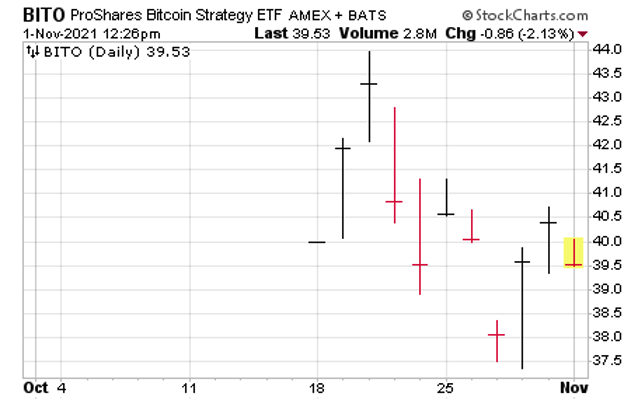Before I get started I want to encourage all of you interested in trading options to sign-up for my free weekly newsletter. No, I’m not going to send you more than the one email a week and no, I’m not running a service. I’m a trader. This is completely free from all marketing. You will find educational topics, research, trade ideas, weekly indicators and more each week. I’ve been on Slope for a long, long time and would love your all of your support. Thanks.
Click the following to sign-up for:
If social media is your thing follow me on:
For those interested in bitcoin there is now a way to get into the cryptocurrency at the price of your choosing. Best of all, you can collect premium while waiting for bitcoin, or more specifically the new ProShares Bitcoin Strategy ETF (BITO), to hit your stated price.
By using cash-secured puts on BITO, you are able to produce a steady stream of premium that can be used as a potential source of income or to simply lower your cost basis on the position.
I take this approach every time I wish to purchase stock. And oftentimes once I am put shares of the stock, or in this case an ETF, I simply sell covered calls against my newly acquired shares.
Why would you ever approach buying a security any other way?
Let’s go over a quick example.
Let’s say you are interested in buying ProShares Bitcoin Strategy ETF (BITO), but not at the current price of 39.53.
You prefer to buy BITO for 35.

Now, most investors would simply set a buy limit at 35 and move on, right? But that approach is archaic. Because you can sell one put for every 100 shares of BITO and essentially create your own return on capital (depending on the strike you choose).
Some say it’s like creating your own dividend and in a way, I kind of agree.
A short put, or selling puts, is a bullish options strategy with undefined risk and limited profit potential. Short puts have the same risk and reward as a covered call. Shorting or selling a put means you are promising to buy a stock at the put strike of your choice. In our example, that’s the 35 strike.
If you look at the options chains for BITO below you will quicky notice that for every 100 BITO shares we want to purchase at 35, we are able to bring in roughly $2.60, or $260 per put contract sold, every 46 days.

The trade itself is simple: Sell to open December 17, 2021 BITO 35 puts for a limit price of $2.60.
Quick note: When selling options, set your limit price just under the mid-price of the bid-ask spread. In the example above the bid-ask price of the 35 strike is 2.55 to 2.65. The mid-price is 2.60, so selling the 35 puts for $2.60, possibly slightly less, seems reasonable. By not selling at the bid we are saving $0.05. Doesn’t seem like a lot, but when you start to add up $0.05 for each trade you place, well, it doesn’t take long to realize the impact over the long term. So, the lesson here is never sell at the asking price, or market price for that matter. Again, using this approach will create significant returns over the long term that you would otherwise forfeit. Trade intelligently!
So, by selling the 35 put options in December, you can bring in $260 per put contract, for a return of 7.4% over 30 days. That’s $2,080, or 59.2% annually. You can use the premium collected from selling the 35 puts either as a source of income or to lower your cost basis.
Just think about that for a second.
You want to buy BITO at 35. It’s currently trading for 39.53. By selling cash-secured puts at the 35 strike you can lower your cost basis to 32.40. That’s 18% below where the ETF is currently trading. And you can continue to sell cash-secured puts on BITO over and over, lowering your cost basis even further, until your price target is hit.
Or, like most investors, you could just sit idly by and wait for BITO to hit your target price of 35–losing out on all that opportunity cost.
In review, by selling cash-secured puts at the 35 strike we receive $260 in cash. The maximum profit is the $260 per put contract sold. The maximum risk is that the short 35 put is assigned and you have to buy the ETF for 35 per share. But you still get to keep $260 collected at the start of the trade, so the actual cost basis of the BITO position is $35 – $2.60 = $32.40 per share. The 32.40 per share is our breakeven point. A move below that level and the position would begin to take a loss.
But remember, most investors would have purchased the stock at its current price, unaware there was a better way to buy a security. We rarely take that approach. We know better. We understand we can purchase stocks at our own stated price and collect cash until our price target is hit. It’s a no-brainer.
As always, if you have any questions, please feel free to email me. And if you want further instruction on how I use the strategy, check out my approach to selling cash-secured puts.

